(First published 8 Jan 2015; updates—21 November 2015, 30 January 2016, 5 April 2016, and 2 September 2022). 
Bunny Nunn was one of Australia’s leading sportsmen of the 1940s and 50s. He excelled at the highest level and left a lasting legacy.
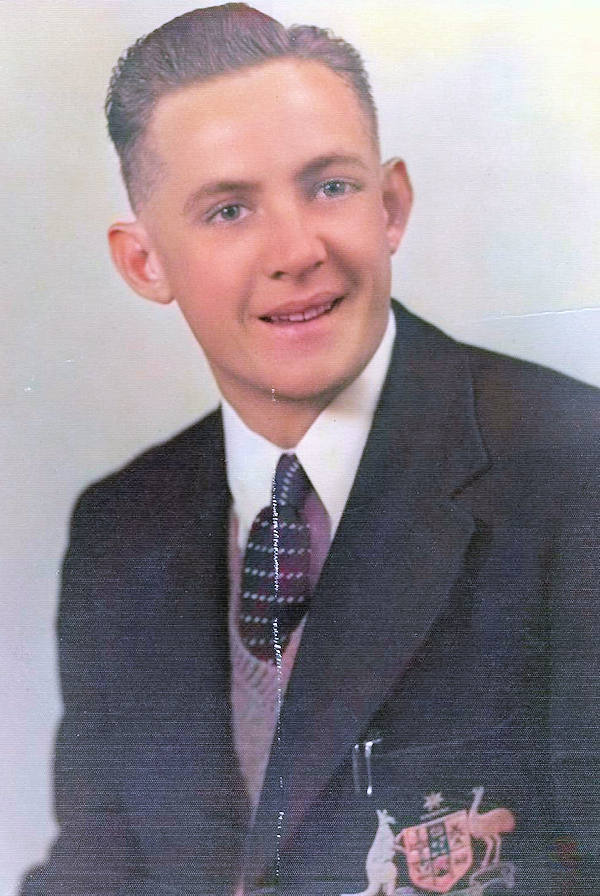
Gordon (Bunny) Nunn, Australian footballer.
Born in Ipswich, Queensland, Gordon David (Bunny) Nunn (1927-2008), was the son of Victor Burnie Nunn and Eliza Heather Dobbie.
His great-grandparents David and Rachel Nunn left Suffolk, England, in 1858 and settled in the Ipswich region of Queensland, Australia, at Dinmore.
Sport (particularly soccer and cricket) was part of growing up for the Nunn children and subsequent generations. Nunns’ paddock at Dinmore hosted cricket and soccer matches in the early days.
Nunn descendants eventually spread out from Dinmore but within 100 years of their arrival, Gordon David Nunn would make the surname known around Australia and many parts of the world.
His success as a football (soccer) player for his club team (St Helens1), his city (Ipswich), his state (Queensland) and his country (Australia) confirm his place as an individual who would have been an elite sportsman in any era.
Bunny’s physical talents made him a sharpshooter in front of goal and from the time he started kicking the round ball at primary school, he scored goals—hundreds of them—in playing against the best in Australia and from other nations.
In one season at Bundamba school he slotted 48 goals, a record for a schoolboy at that time.
Why Bunny?
Bunny was a difference maker and was on the winning side more often than not; and mainly because of the rare gifts he brought to the pitch.
The nickname Bunny has an obvious connection to the Nunn surname and there have been several Bunny Nunns.
In a conversation I had with Bunny in 1998, he told me his dad’s brother Cecil was the ‘first’ Bunny in their family and young Gordon also acquired the nickname.
The fact was well known at the time because Cecil was also a fine footballer and represented Queensland before his nephew did.2
Looking through the newspaper reports of the day gives a wonderful picture of Bunny’s achievements.
An immediate impact
In the only mention of the then 16-year-old Bunny Nunn in May 1943, The Queensland Times newspaper reported that he scored a goal in his club side St Helens’ 2-0 win over Blackstone Rovers.3
Some of the first of thousands of words to be written about the talented teenager were:
Bunny Nunn, however, caught the goalie on the wrong foot and scored the first goal for Saints.3
Presumably this was one of his first appearances in the top grade even though the obituary published after his passing in 2008 reported that his debut was in 1945 as a 17-year-old.4
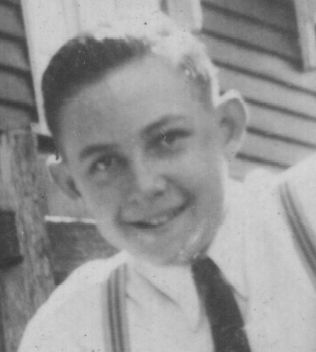
Gordon David (Bunny) Nunn aged about 12.
Because the official premiership competition was suspended for a couple of seasons during war-time (1942-43 according to one website)5, it’s debatable what year should be assigned as his first-class debut.
Five goals on a losing team
Putting aside what the official records say, Bunny arrived with a bang—and five goals—in the 1944 season according to the first reported premiership match in which he played on 10 June 1944.6 Bunny’s team St Helens lost by one to Y.M.C.A. in a game in which 15 goals were scored.
In the next six games, Bunny added another 26 goals including an incredible eight in a 10-1 romp over Blackstone Rovers.7
In the match that confirmed St Helens as 1944 premiers, Bunny slotted four goals past the keeper.8 It also has to be remembered that Bunny may have scored other goals in premiership games but without an official or newspaper account of it, this record of his achievements is incomplete.
Broken windows
In 1945, Bunny added at least 22 goals to his tally for St Helens despite several months’ absence for military service when he joined the RAAF in May.
He did return for the final match of the season on 18 August which confirmed St Helens as premiers.9 Bunny netted three goals in a 6-1 result.
[As an aside, Bunny’s second cousin Arnold Nunn recalls visiting him at Ipswich when he too was in the RAAF during the war. Arnold was based at Amberley after returning from active duty in New Guinea and spent time visiting Bunny and Doug Nunn and their parents Vic and Heather. On one occasion Arnold, Bunny and Doug were playing soccer inside a church hall and some windows were ‘damaged’. Bunny’s grandfather David (aka Dick) and Arnold’s grandfather Arthur along with several other Nunn brothers were keen cricketers at Dinmore in the late 1890s.]
Lean season
In the nine reports found of club matches played in 1946, Bunny had a lean season by his prolific scoring standards with only 11 goals. It seems that St Helens’ fortunes depended very much on Bunny’s boot because they did not win the premiership that season; it went to Y.M.C.A.10
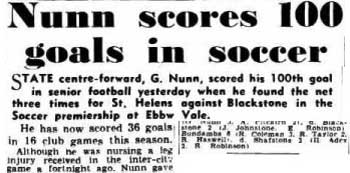
Newspaper clipping of Bunny’s milestone.
In 1948, his exploits helped St Helens win the premiership, the Hilton Shield and the Tristram Shield.13
The Tristram Shield was a prestigious knockout club competition, and the Hilton Shield seems to have been played for along similar lines.
Bunny did reach a significant milestone in 1947 when he notched his 100th goal in first division—and he did it in style with a hat-trick.11
One report also noted that Bunny had notched a season tally of 36 goals in 16 games.12 As best can be ascertained, Bunny took to 40 his total of goals for the season and was, of course, the leading scorer.
The goals kept flowing and included five in a game against Eastern Suburbs,14 plus hat-tricks against Bundamba,15 Dinmore,16 Y.M.C.A.17 and Thistle.18
Offers to play elsewhere
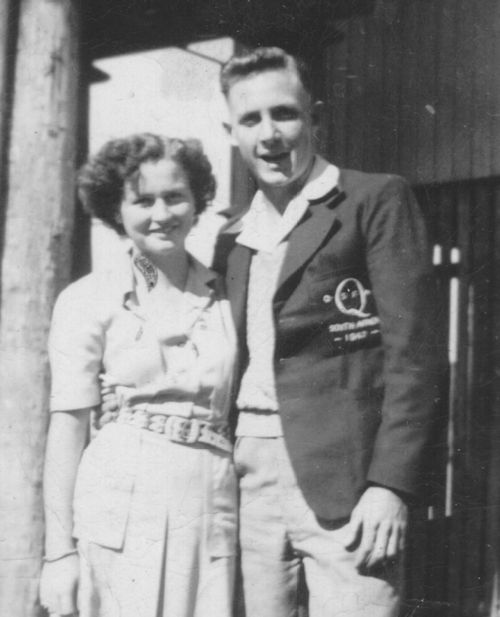
Bunny Nunn in 1947 with his future wife Elizabeth Smith. Bunny is wearing a Queensland team jacket.
Bunny’s prodigious talents brought offers to play interstate and overseas. He apparently never considered leaving Australia but did seriously consider moving to Sydney in 1949 when the Metters club based at Canterbury pursued his signature.
Bunny even flew to Sydney in April and actually played in a premiership match putting away a signature goal in a 2-1 win over Granville.19
This was an intense time for Bunny as another Sydney club (Drummoyne) and a Brisbane club (Corinthians) also tried to convince him to join them.19
As it turns out, Bunny had no choice but to stay with his mates at Ebbw Vale where St Helens was based because the Ipswich Soccer Management Committee applied their rule that a player was barred from transferring to another club after half the season’s game had been played.20
Marriage and children
There was also a young lady named Elizabeth Grieve Smith21 who had attracted his attention and to whom he was married in February 1950.22
Despite the distractions, 1949 was another productive year as the goals continued to flow. It was reported in early May23 that his season tally had reached 19 and many more flowed including five in a game against Corinthians.24
The Sunday Mail newspaper reported that he actually scored six times24 but, having worked in newspapers for 40-plus years including for the aforesaid publication, mistakes do happen.
In researching Bunny’s career, I have seen several errors in newspaper reports including Bunny’s first name being given as George25 instead of Gordon. As well, The Sydney Morning Herald also reported that “George” Nunn had already signed on to play with Metters.26
Family comes first
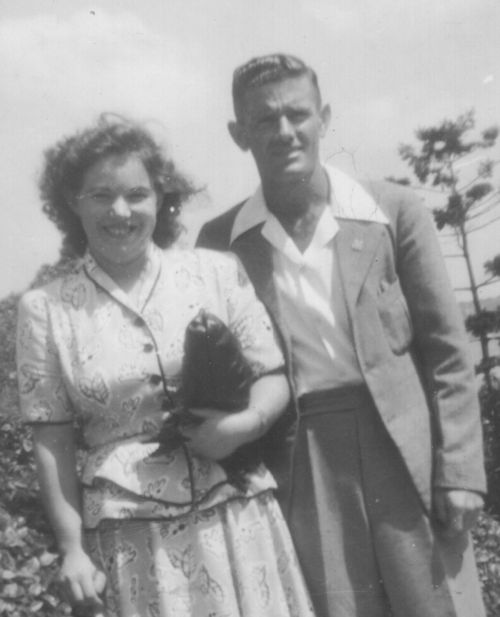
Bunny and Betty Nunn.
Bunny and Betty obviously planned to have a family and that may have weighed heavily on a young man not sure about moving away from familiar surroundings—and extended family.
There is a clear insight into Bunny’s character to be found in an article27 that appeared in a small Sunshine Coast-based publication The Nambour Chronicle and North Coast Advertiser.
A Perc Allen “interviewed” Bunny and Betty on their honeymoon at Maroochydore and wrote:
At ‘Seaspray’, Maroochydore, I met Mr. G. (“Bunny”) Nunn, famous Soccer footballer, who has been selected to represent Australia in the visit to South Africa. I found “Bunny” a softly spoken, athletic looking man, who was enjoying his honeymoon at Maroochydore.
He told me he had recently married Miss Betty Smith, of Darra, and regretted he would be unable to take her with him to South Africa. He leaves in about four weeks’ time. The stay in South Africa will be about three months, during which five tests will be played, he told me.
“I have played Soccer football since I was knee high to a grasshopper,” said “Bunny”. He has been playing international football for the past four years. He went to New Zealand with the Australian team in 1948 and has played against South Africa, New Zealand and Yugoslavia in Australia. “Bunny” plays in the “centre pin” position of centre forward with the St. Helens Club at Bundamba.28 Asked if he could tell of any amusing incidents, he said the most amusing he could remember at the time was one at Auckland where the Aussies won by 9 goals to 1.
During the match a penalty was awarded Auckland for an infringement by an Australian player. While the Australian goalkeeper was placing himself in readiness for the shot, the Auckland player kicked the ball through the goal and the referee said “goal”. No whistle had been blown, permitting the ball to be kicked, and the incident was so humorous the Australians did not protest.
In reply to further questions, Mr. Nunn said he had made his first trip to Maroochydore, which he thought was a grand place for a holiday, in his single days, he said, he went to the South Coast, but that was too noisy for a married man. He now preferred the quiet of our seaside resort. “I’ll be back one of these days,” said “Bunny”.27
Significant goal tally
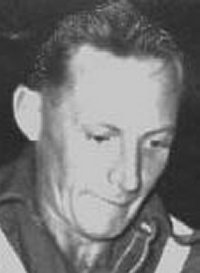
Focused on the ball … Bunny Nunn.
It has been reported that Bunny scored about 700 goals in his career including a record 89 for St Helens in 1950 plus another 20 (Alan Fouche’s obituary4 says it was 18) for Australia on their tour to South Africa.29
With his wife Betty pregnant, Bunny finally decided to accept an offer to switch from his beloved St Helens and play with Caledonians30 in 1951; not 1953 as my erstwhile colleague Alan Fouche reported in his excellent obituary about Bunny.4
I can assure readers that Alan Fouche would be unhappy that anything was incorrect in an article to which he put his name. He was a consummate wordsmith and had a marvellous eye for picking up errors of fact, spelling or grammar.
In his defence, he would have been relying on a number of sources including a file of newspaper clippings that Queensland Newspapers kept on Bunny. I scanned through the clippings many years ago but took no notes at the time.
Signing bonus
In the obituary, Alan Fouche quoted Bunny speaking of his time with Caledonians:
“I signed on for one pound and threepence a game,” he later recalled, “which to me was a lot of money in those days.”4
But, to further underscore what I previously stated about what players actually said and how newspapers recorded them, a 1989 report in The Sunday Mail by another of my former colleagues Tom Linneth, quotes Bunny giving different details about the switch to Caledonians.29
It was a point of contention because it cost Bunny the chance of playing for Australia at the 1956 Olympics in Melbourne.
Of the situation, Tom Linneth wrote, quoting Bunny:
Nunn was ruled ineligible because he had turned professional with the Brisbane club Caledonians. “I signed on for 20 pounds and three pounds a game,” he said, “which to me was a lot of money in those days. I had a young family to support and there were not too many opportunities to get a few bob31 out of the game. It helped to give me a better start as I wanted to make my family future more secure.”29
And little wonder Bunny took up the offer given the various factors at play including that it was post-war, his first child had just been born and the representative matches for which he was selected required much time away from work and family including three months in South Africa. In those days players would not have been as richly rewarded as they now are.
Team struggles
Bunny’s departure had an immediate impact on St Helens’ fortune and—after just one season—it was facing relegation from the top grade as The Queensland Times30 noted in July 1951:
The Ebbw Vale team has an impressive record over the past four seasons, as in 1947 and 1949 it won the first division premiership and the Hilton and Tristram Shields. In 1949 it was again successful, winning the two shields—the Tristram Shield outright. This season, their key attacking forward, Gordon “Bunny” Nunn transferred to Caledonians, and since then St Helens have made many experiments, but up to date none can be considered to have been successful.30

From left are brothers David (aka Dick, left) and Arthur Nunn. Next are their sons and first cousins Vic (left) and George Nunn; and next are second cousins Bunny Nunn (left) and Gordon Nunn, respective sons of Vic and George Nunn and grandsons of David and Arthur.
Bunny actually spent three seasons with Caledonians but did not enjoy the same team success—as far as premierships go—that he’d had with St Helens although he kept up his goal-scoring ways netting at least 27 in his first season.
A report from May 195132 said his season tally to that point was 22. To that he added four goals in June33 and another in September.34
Again, without newspaper reports, there is no way I have of knowing if he scored more goals but it’s almost certain that he did.
In October, Bunny’s Caledonians played a 2-2 draw35 with his old club St Helens in the Hilton Shield final. Bunny’s older brother Doug36 played on the wing for St Helens that day.
How others saw Bunny
In 2015, I spoke with Jim Walker who also played at St Helens at the same time as Bunny. He said Bunny should be remembered more for the man he proved to be than the great player he was.
“He could fire them from everywhere and loved to interchange with the winger,” he said. And Jim clearly remembers what he described as the best goal he’s ever seen: “Bunny trapped the ball at the 18-yard line with his back to the goal; he pivoted on his left leg and turned in one movement; the ball falling on top of his foot and ending up in the top corner of the net.”
In 1952, Bunny had another highly productive season with Caledonians having 53 goals in the bag by early August.37
Bunny polished off the 1953 season with eight goals in the final two games38 and advance to 59 his tally.
Goal orientated
A former Australia Soccer Federation chairman Ian Brusasco—who also played against Bunny—once said that the striker had an insatiable appetite for goal-scoring.29
“Bunny was one of the all-time great attacking players. If it was on for a goal then Bunny Nunn wanted it. He fought tooth and nail to get a crack at goal.”29
And, like the legendary Argentine player Diego Maradona, Bunny also fooled the referee by punching the ball into the net for a goal, something to which he ruefully confessed in 1989.29
In 1954, Bunny was back with St Helens and notched 16 goals in the nine club matches for which reports can be found.39,40,41,41,43,44,45,46,47
There were a couple of newspaper reports48,49 in 1954 that Bunny had quit representative football but that did not happen because in July, Bunny surprised everyone by announcing that would play on.50
Slowing with age
He had been battling an ankle injury and missed several club games so perhaps this was a factor in his initial decision to retire.
Because there are no digitised records yet available from 1955 onwards, I have no specific references to newspaper reports for a significant part of Bunny’s career but, for those interested, this link will take you to the spreadsheet I prepared for the years 1943 to 1954.
He went on to have many more successful seasons and was most proud of his achievements as the coach of Queensland’s team in 1962 as he presided over three wins against New South Wales.29
Bunny’s international career was significant and, according to one website,51 he played for Australia 27 times scoring 18 goals. I have found newspaper reports for 19 internationals and several other games in which Australia played various teams.
Rolling retirement
After he cut ties with soccer, Bunny turned his energies to lawn bowls at which he enjoyed considerable success, no doubt because of his undiminished natural sporting acumen.
[NOTE: Bunny Nunn and the author’s father are second cousins and share the same name: Gordon David Nunn. The composite image above as well as this link explains show they relate. Bunny was born 9 May 1927 (died 13 Sep 2008) and Gordon on 15 May 1925 (died 8 June 1975 in an accident).]
UPDATE: In a book called A History of Ipswich Soccer, there’s a section that mentions several Nunns who represented Ipswich. I’ve included links from the named individuals to their family tree pages. It’s interesting that Alf Nunn (son of Amos Nunn) who was a brother of the best-known Bunny’s grandfather David (aka Dick) is referred to as the first “Bunny” because that tag was thought to belong to Alf’s first cousin Cec Nunn.
The excerpt reads:
The Nunns
These came from several families at Dinmore and Booval – all related.
The first to make his mark as a player was Alf – the original “Bunny”. He played for Rats and, as a winger, for Ipswich against New South Wales in 1912.
Dick Nunn’s sons, Roy, Vic, Arn, Cec all played a part, Cec being a State player. Vic’s son, Gordon and Doug, both played with Saints, Gordon (‘Bunny’) being the greatest of the Nunns. A centreforward of outstanding goal scoring ability, he played in 16 Test Matches for Australia, as well as 11 international games, scoring 18 goals for his country.
(A snippet from his past, I have been given is that Bunny’s grandfather Jim Dobbie of the early 1890’s was a strong ‘shooter’).
From the Dinmore area came Eric (an International and Interstate left half; he took Alec Gibb’s place in the Queensland team in the 20s), his brothers Bill, Frank, and Dud, the last named playing with Saints as an outside left. Eric also served as an interstate selector in the 1950’s.
©Warren Nunn, oznunns.com.au (2015)
References
- St Helens was based at Ebbw Vale, Ipswich, Queensland, but Bunny also played with Brisbane clubs Caledonians and Azzurri and had one game for Sydney club Metters. See Ref 20.
- Sportographs. (1952, November 15). Queensland Times (Ipswich) (Qld. : 1909 – 1954), p. 5 Edition: Daily.. Retrieved January 10, 2015, from http://nla.gov.au/nla.news- article122034747.
- Soccer opens with one match. (1943, May 24). Queensland Times (Ipswich) (Qld. : 1909 – 1954), p. 3 Edition: Daily. Retrieved January 8, 2015, from http://nla.gov.au/nla.news- article114003867.
- Fouche, A., Soccer icon loved bowls. (2008, Oct 27). The Courier-Mail (Brisbane), p. 61.
- thewashingline.footballbrisbane.com.au.
- High scoring in soccer. (1944, June 11). Sunday Mail (Brisbane) (Qld. : 1926 – 1954), p. 10. Retrieved January 8, 2015, from http://nla.gov.au/nla.news-article97940791.
- Scored 8 Goals At Soccer. (1944, July 16). Sunday Mail (Brisbane) (Qld. : 1926 – 1954), p. 9. Retrieved January 8, 2015, from http://nla.gov.au/nla.news-article97947984.
- Soccer title to St. Helens. (1944, August 6). Sunday Mail (Brisbane) (Qld. : 1926 – 1954), p. 11. Retrieved January 8, 2015, from http://nla.gov.au/nla.news-article97942311.
- Weekend sports on various fields. (1945, August 20). Queensland Times (Ipswich) (Qld. : 1909 – 1954), p. 3 Edition: Daily. Retrieved January 8, 2015, from http://nla.gov.au/nla.news- article114608561.
- Soccer Premiership won on Averages. (1946, August 11). Sunday Mail (Brisbane) (Qld. : 1926 – 1954), p. 13. Retrieved January 8, 2015, from http://nla.gov.au/nla.news- article98376544.
- St. Helens unbeatable in soccer premiership. (1947, August 18). Queensland Times (Ipswich) (Qld. : 1909 – 1954), p. 7 Edition: DAILY. Retrieved January 8, 2015, from http://nla.gov.au/nla.news- article118393972.
- Nunn scores 100 goals in soccer. (1947, August 17). Sunday Mail (Brisbane) (Qld. : 1926 – 1954), p. 13. Retrieved January 8, 2015, from http://nla.gov.au/nla.news- article98322643.
- St. Helens win soccer shield with late goal. (1947, September 26). The Courier- Mail (Brisbane, Qld. : 1933 – 1954), p. 3 Supplement: Sporting supplement. Retrieved January 8, 2015, from http://nla.gov.au/nla.news-article49321149.
- St. Helens, Bundamba Rangers in soccer wins. (1948, May 24). Queensland Times (Ipswich) (Qld. : 1909 – 1954), p. 8 Edition: Daily. Retrieved January 9, 2015, from http://nla.gov.au/nla.news- article125587861.
- Three get hat-trick in soccer. (1948, April 25). Sunday Mail (Brisbane) (Qld. : 1926 – 1954), p. 8. Retrieved January 9, 2015, from http://nla.gov.au/nla.news-article98318633.
- Soccer—Three local teams have Tristram Shield wins. (1948, July 12). Queensland Times (Ipswich) (Qld. : 1909 – 1954), p. 5 Edition: Daily. Retrieved January 9, 2015, from http://nla.gov.au/nla.news- article117106198.
- Rangers upset by soccer tail-enders. (1948, July 19). Queensland Times (Ipswich) (Qld. : 1909 – 1954), p. 6 Edition: Daily. Retrieved January 9, 2015, from http://nla.gov.au/nla.news- article117111864.
- Saints’ soccer shield record. (1948, July 25). Sunday Mail (Brisbane) (Qld. : 1926 – 1954), p. 8. Retrieved January 9, 2015, from http://nla.gov.au/nla.news- article98324635.
- G. Nunn Most Sought After Soccer Player. (1949, May 12). Queensland Times (Ipswich) (Qld. : 1909 – 1954), p. 3 Edition: DAILY. Retrieved January 9, 2015, from http://nla.gov.au/nla.news- article117084832.
- Nunn Move (1949, May 28). Brisbane Telegraph (Qld. : 1948 – 1954), p. 16. Retrieved April 5, 2016, from nla.gov.au/nla.news-article212269449.
- oznunns.com.au.
- Wedding. (1950, March 10). Queensland Times (Ipswich) (Qld. : 1909 – 1954), p. 5 Edition: Daily. Retrieved January 9, 2015, from http://nla.gov.au/nla.news- article124640180.
- Rovers-Saints soccer match “crowd pleaser”. (1949, May 9). Queensland Times (Ipswich) (Qld. : 1909 – 1954), p. 3 Edition: Daily. Retrieved January 9, 2015, from http://nla.gov.au/nla.news- article117096397.
- Soccer Football Field day for Nunn against Corinthians. (1949, July 25). Queensland Times (Ipswich) (Qld. : 1909 – 1954), p. 5 Edition: Daily. Retrieved January 9, 2015, from http://nla.gov.au/nla.news- article124632892.
- Nunn scores 6 more goals. (1949, July 24). Sunday Mail (Brisbane) (Qld. : 1926 – 1954), p. 11. Retrieved January 9, 2015, from http://nla.gov.au/nla.news-article98290707.
- Metters Gains Test Forward. (1949, April 29). The Sydney Morning Herald (NSW : 1842 – 1954), p. 7. Retrieved January 9, 2015, from http://nla.gov.au/nla.news-article18113265.
- To Play Soccer In South Africa. (1950, March 17). Nambour Chronicle and North Coast Advertiser (Qld. : 1922 – 1954), p. 5. Retrieved January 9, 2015, from http://nla.gov.au/nla.news-article78381997.
- St Helens was actually based at Ebbw Vale, an adjoining suburb to Bundamba. See https://goo.gl/maps/YnkOV.
- Linneth, T., Nunn no bunny at goal nets. (1989, October 27).The Sunday Mail (Brisbane).
- Main soccer interest now on relegation. (1951, July 19). Queensland Times (Ipswich) (Qld. : 1909 – 1954), p. 6 Edition: Daily. Retrieved January 9, 2015, from http://nla.gov.au/nla.news-article118227911.
- To those who may not know, the phrase “a few bob” referred to money; a bob meaning a shilling.
- Blackstone leads in soccer shield. (1951, May 14). Queensland Times (Ipswich) (Qld. : 1909 – 1954), p. 4 Edition: Daily.. Retrieved January 9, 2015, from http://nla.gov.au/nla.news-article124622859.
- Football. (1951, June 10). Sunday Mail (Brisbane) (Qld. : 1926 – 1954), p. 14. Retrieved January 9, 2015, from http://nla.gov.au/nla.news-article98341607.
- Blackstone have easy win in soccer fixture. (1951, June 18). Queensland Times (Ipswich) (Qld. : 1909 – 1954), p. 6 Edition: Daily.. Retrieved January 9, 2015, from http://nla.gov.au/nla.news-article124620774.
- Soccer Play-off to decide Hilton Shield final. (1951, October 1). Queensland Times (Ipswich) (Qld. : 1909 – 1954), p. 4 Edition: Daily. Retrieved January 9, 2015, from http://nla.gov.au/nla.news-article118228124.
- oznunns.com.au.
- Nunn out of team. (1952, August 19). The Courier-Mail (Brisbane, Qld. : 1933 – 1954), p. 6. Retrieved January 9, 2015, from http://nla.gov.au/nla.news-article50531891.
- Rovers get 3 Soccer wins. (1953, September 20). Sunday Mail (Brisbane) (Qld. : 1926 – 1954), p. 29. Retrieved January 9, 2015, from http://nla.gov.au/nla.news- article98276735.
- Soccer Cup. (1954, March 29). The Courier-Mail (Brisbane, Qld. : 1933 – 1954), p. 7. Retrieved January 9, 2015, from http://nla.gov.au/nla.news-article50587277.
- Soccer: S. Kitching nets five good goals. (1954, April 5). Queensland Times (Ipswich) (Qld. : 1909 – 1954), p. 5 Edition: Daily. Retrieved January 9, 2015, from http://nla.gov.au/nla.news-article118240886.
- Soccer football Rats earned big win over Saints. (1954, April 12). Queensland Times (Ipswich) (Qld. : 1909 – 1954), p. 5 Edition: Daily. Retrieved January 9, 2015, from http://nla.gov.au/nla.news-article118238327.
- Rovers down Rats: Rangers, Saints win. (1954, May 10). Queensland Times (Ipswich) (Qld. : 1909 – 1954), p. 5 Edition: Daily. Retrieved January 9, 2015, from http://nla.gov.au/nla.news-article118258776.
- Rats-Thistle now share soccer lead. (1954, June 21). Queensland Times (Ipswich) (Qld. : 1909 – 1954), p. 5 Edition: Daily. Retrieved January 9, 2015, from http://nla.gov.au/nla.news-article118258990. .
- Rangers-Saints played hard tie. (1954, June 28). Queensland Times (Ipswich) (Qld. : 1909 – 1954), p. 3 Edition: Daily. Retrieved January 9, 2015, from http://nla.gov.au/nla.news-article118257294. .
- Rats too good for “Callies”. (1954, July 5). Queensland Times (Ipswich) (Qld. : 1909 – 1954), p. 5 Edition: Daily. Retrieved January 9, 2015, from http://nla.gov.au/nla.news-article118257144. .
- Rovers won great game. (1954, July 12). Queensland Times (Ipswich) (Qld. : 1909 – 1954), p. 5 Edition: Daily. Retrieved January 9, 2015, from http://nla.gov.au/nla.news- article118248934. .
- Record crowd saw Saints win soccer. (1954, July 19). Queensland Times (Ipswich) (Qld. : 1909 – 1954), p. 5 Edition: Daily. Retrieved January 9, 2015, from http://nla.gov.au/nla.news-article118248717.
- Soccer. (1954, May 13). Townsville Daily Bulletin (Qld. : 1885 – 1954), p. 2. Retrieved January 10, 2015, from http://nla.gov.au/nla.news-article62515595.
- Nunn Out Of ‘Big’ Soccer. (1954, May 13). Newcastle Morning Herald and Miners’ Advocate (NSW : 1876 – 1954) , p. 12. Retrieved January 10, 2015, from http://nla.gov.au/nla.news-article134657164.
- Big Soccer surprise; Nunn back. (1954, July 6). The Courier-Mail (Brisbane, Qld. : 1933 – 1954), p. 8. Retrieved January 10, 2015, from http://nla.gov.au/nla.news- article50595776.
- http://www.ozfootball.net/ark/Player s/N/NU.html.
